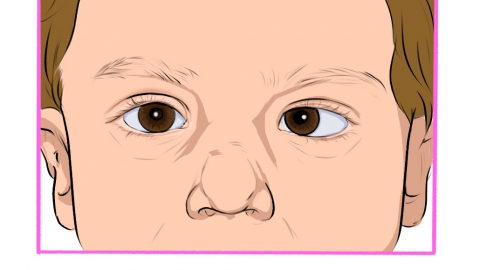Why Do Children Develop Strabismus?
Generally, children may develop strabismus due to imbalanced development of eye muscles, genetic factors, refractive errors, congenital cataracts, ocular trauma, or other causes. It is recommended to seek timely medical attention, identify the underlying cause, and proceed with symptomatic treatment under a physician's guidance. Detailed explanations are as follows:

1. Imbalanced Development of Eye Muscles: Incomplete development and uneven contraction forces of children's eye muscles can lead to coordination disorders in eye movement, causing strabismus. This is often detected at birth or during early childhood and manifests as misaligned gaze between the two eyes. Early eye muscle training, such as alternating eye covering and following moving targets, can help balance muscle strength. Some children may gradually return to normal with consistent training at a young age.
2. Genetic Factors: If there is a family history of strabismus, children have a higher probability of inheriting related genes, which may lead to abnormal development of the eye muscles or nerves and result in strabismus. This is often comitant strabismus, with potentially normal vision in both eyes. Parents should closely monitor their child's visual habits, seek timely examination upon noticing signs of strabismus, and intervene early after diagnosis through corrective lenses or training to reduce long-term effects of genetic factors.
3. Refractive Errors: High hyperopia, myopia, or astigmatism in children that remains uncorrected can lead to blurred vision. Excessive eye accommodation may then cause strabismus. High hyperopia often leads to esotropia, while myopia may cause exotropia. Timely vision examination, wearing appropriate glasses to correct refractive errors, regular follow-ups to adjust glasses prescriptions, and visual function training such as fusion training can help alleviate strabismus symptoms.
4. Congenital Cataracts: Congenital lens opacity blocks light entry, affects retinal imaging, causes abnormal visual development, and leads to strabismus, often accompanied by low vision and white opacity in the pupil area. Prompt cataract removal surgery via phacoemulsification should be performed to clear the cloudy lens. After surgery, corrective glasses should be worn or an intraocular lens implanted to provide a clear environment for visual development. Strabismus correction training should also be conducted to improve abnormal eye positioning.
5. Ocular Trauma: Eye injuries such as impact or penetrating trauma may damage the extraocular muscles or their innervating nerves, causing muscle movement disorders, strabismus, and symptoms such as eye pain and swelling either immediately or several days after injury. Prompt medical attention is necessary to treat the wound, and medications such as tobramycin eye drops, erythromycin ointment, and vitamin B1 tablets should be used as directed to prevent infection and support nerve nutrition. If strabismus persists after injury recovery, an extraocular muscle correction surgery may be performed after medical evaluation to adjust the muscle attachment points and restore normal eye movement.
In daily life, parents should limit children's screen time, avoid prolonged near work, and encourage a 5-minute rest after every 30 minutes of eye use, including looking into the distance to relax the eyes. Parents should also spend time with children engaging in outdoor activities such as ball games and flying kites to promote coordinated eye movement and help prevent or support treatment for strabismus. Regular vision check-ups are important, especially completing a comprehensive eye examination before age 3 to detect and address any issues early.










